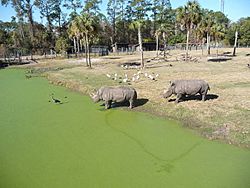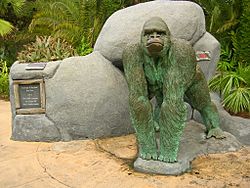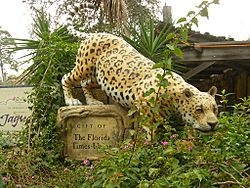Jacksonville Zoo and Gardens facts for kids
 |
|
| Date opened | May 12, 1914 |
|---|---|
| Location | 370 Zoo Parkway, Jacksonville, Florida, 32218, United States |
| Land area | 122 acres (49 ha) |
| Coordinates | 30°24′14.67″N 81°38′36.04″W / 30.4040750°N 81.6433444°W |
| No. of animals | 2,000 |
| Memberships | AZA |
The Jacksonville Zoo and Gardens is a super cool place in Jacksonville, Florida. It's right by the Trout River, which flows into the big St. Johns River. The zoo covers about 122 acres. That's like 90 football fields! It's home to over 2,000 animals and 1,000 different kinds of plants.
The zoo started small in Springfield. Now, it's one of Jacksonville's top spots. More than a million people visit it every year!
Some of the most popular areas are the Range of the Jaguar and the Land of the Tiger. The Range of the Jaguar even won an award in 2005! The Land of the Tiger opened in 2014. It has a special path where you can walk through and see Sumatran and Malayan tigers up close. You can also spot hornbills, Visayan warty pigs, babirusas, and otters there.
Other cool exhibits include the Plains of East Africa. Here you can see animals like rhinos. The Australian Outback has lorikeets, cassowaries, and wallabies. The African Forest is home to great apes and lemurs. Wild Florida shows off animals that live in Florida, like otters, black bears, and Florida panthers.
The zoo cares a lot about protecting animals. It works with over 50 conservation projects around the world. It also helps with more than 95 Species Survival Plans. These plans help save endangered animals. Since 1999, the zoo has been a home for a large group of wild wood storks. These birds are rare in North America. They have made a permanent home in a tree overlooking the Plains of Africa.
Contents
- Zoo History: From Fawn to Famous
- Exploring the Zoo's Amazing Exhibits
- African Adventures: Plains and Forests
- African Forest: Home of the Great Apes
- Wild Florida: Local Wildlife Wonders
- Range of the Jaguar: A South American Journey
- Australian Adventure: Down Under Fun
- Children's Play Park: Fun for All Ages
- Stingray Bay: Touch and Feed Rays
- Asian Bamboo Garden and Komodo Dragon Exhibit
- Land of the Tiger: A Tiger's World
- Animal Conservation: Helping Wildlife Thrive
- Beautiful Botanical Gardens
- Zoo Services: Food and Fun
- Education Programs: Learn and Explore
- Future Plans: What's Next for the Zoo?
- Images for kids
Zoo History: From Fawn to Famous
The Municipal Zoo first opened its doors on May 12, 1914. It was in the Springfield area of Jacksonville, Florida. The very first animal at the zoo was a baby red deer.
On July 19, 1925, the zoo moved to a new, bigger spot. This new home was 37.5 acres. It was located on the Trout River in the city's Northside area.
One of the most important animals in the zoo's history was a jaguar named Zorro. Zorro was a wild-born black jaguar. He came to the zoo in August 1967. Back then, black jaguars were very rare in zoos. Zorro lived at the zoo for 19 years. He had many cubs that were sent to other zoos across North America. In 2003, the zoo found that almost all black jaguars in North American zoos were related to Zorro!
By the late 1960s, the zoo had many exotic animals. But it needed a lot of money to keep going. Community leaders and Mayor Hans Tanzler worked together. They formed a committee to save the zoo from closing.
A big plan to rebuild the zoo started in 1992. Over $20 million was raised from public money and private gifts. Many new things were built. These included a new entrance, a bigger train ride, and homes for elephants and great apes. They also built the RiverBranch Foundation Animal Medical Center and the PepsiCo Foundation Education Campus. The 11-acre Plains of East Africa exhibit was also redone. Other exhibits added were Stingray Bay, Tuxedo Coast, and the Asian bamboo garden.
In December 2003, the zoo's name officially changed. It became the Jacksonville Zoo and Gardens. Over the next five years, new exhibits opened. These included the famous Range of the Jaguar and the Savanna Blooms botanical garden. A Children's Play Park also opened. The zoo also started to be known as a botanical garden.
Today, the zoo is 89 acres. That's more than double its original size on the Trout River! It houses over 2,400 rare animals and 1,500 unique plant species. The zoo helps protect endangered species and local plants and animals.
Exploring the Zoo's Amazing Exhibits
The Jacksonville Zoo and Gardens has many exciting areas to explore. Each one takes you to a different part of the world!
African Adventures: Plains and Forests
The northern part of the zoo is filled with exhibits about Africa.
River Valley Aviary: Birds of a Feather
This aviary opened in April 1996. It's a huge space, over 9,000 square feet, where birds can fly freely. It has a big waterfall. You can see lesser flamingos, Guinea fowl, storks, and hammerkops. Later, Asian animals like muntjac and Victoria crowned pigeons were added. The zoo was one of the first in the US to successfully breed saddle-billed storks. Next to the aviary is the Ruzizi Streambank. Here you might spot a milky eagle owl.
Plains of East Africa: A Safari Walk
This is one of the first big exhibits you see. You walk on a raised path, giving you a great view of the animals. This area was updated in 1996.
You'll first see Nile crocodiles, warthogs, and Stanley cranes. These birds live with Leadbeater's ground hornbills. The zoo was the first in North America to successfully breed these hornbills.
In a large, shady pen, you'll find Eastern bongos, pink-backed pelicans, and Egyptian geese. This area is also home to a large group of wood storks. These endangered birds are native to Florida.
The cheetah exhibit is 300 feet long. It's home to two cheetahs. Across a small water area, you'll see southern white rhinoceroses, greater kudu, sitatungas, and ostriches. This 2.5-acre exhibit gives the animals lots of room. The zoo has had many successful births of southern white rhinos.
Further along the path, you'll find Okapi and Grevy's zebras.
Elephant Plaza: Gentle Giants and Big Cats
Here, you get a close look at the zoo's three African elephants. They have a huge 275,000-gallon pool! The zoo is one of the few places that houses male elephants. One male elephant, Ali, was given to the zoo by Michael Jackson in 1997.
This area also has a reptile house. You can see Egyptian cobras, green mambas, and a 12-foot African rock python named Solomon. Smaller exhibits nearby feature bustards, fruit bats, klipspringers, and lappet-faced vultures.
Nearby is Mahali Pa Simba, which means "Place of the Lion" in Swahili. This 1-acre area is home to the zoo's male lions, Catali and Mshoni, and females, Tamu and Laini. The zoo welcomed three lion cubs in 2014!
Colobus monkeys live near the lions. These monkeys from East Africa love to leap from tree to tree. You can watch them in their lively home.
Leopards are at the southern end of the path. Their exhibit has a giant artificial tree where they love to rest. The zoo successfully bred this rare species in 2010. The leopards here are Amur leopards. They are from Siberia, Russia, and are one of the most endangered cat species in the world.
Giraffe Overlook: Eye to Eye with Giraffes
This covered walkway gives you a view across a replica of the African Savanna. You can even get eye-to-eye with the zoo's herd of seven giraffes! You can buy drinks and special giraffe food here. The giraffe exhibit is now over 2 acres, much bigger than before. Reticulated giraffes and other animals like wattled cranes and saddle-billed storks live in this area.
African Forest: Home of the Great Apes
The African Forest lets you see different primates from our planet. While monkeys and lemurs are here, the apes are the main stars. This exhibit opened in 1998 and 1999. It cost $20 million to build. It was the first time the zoo had western lowland gorillas and bonobos. The zoo's bonobo collection is one of only nine in North America! This area also became home to the zoo's siamangs and pygmy marmosets. Later, new homes were built for chimpanzees and mandrills. The old monkey island was changed into a lemur exhibit.
Over the years, some things have changed. The pygmy marmosets moved to the Range of the Jaguars in 2004. The chimpanzees went to another zoo in 2007. In 2018, this exhibit was renamed the African Forest.
Wild Florida: Local Wildlife Wonders
This area shows animals that live in Florida. Some animals here used to live in Florida but are now gone from the wild in the state. You can see American alligators, black bears, Coyote, Florida panthers, white-tail deer, bobcats, and bald eagles.
In 2007, the old flamingo exhibit was changed for the eagles. This allowed the zoo to get a pair of whooping cranes. The reptile house in this area shows many different reptiles and amphibians from Florida. You can see Eastern diamondback rattlesnakes, cottonmouths, and indigo snakes.
This area also has the Manatee Critical Care Center. Injured or sick manatees from Florida and Georgia waterways are brought here. They get treatment and recover before being released back into the wild. Sometimes, there might not be any manatees visible, as they are only there for rehabilitation.
Range of the Jaguar: A South American Journey
This exhibit won an award in 2005 for being the best exhibit of the year. It has the most animals of any exhibit at the zoo. It features the largest jaguar exhibit in North America. The jaguars have many pools to play in. You might even see a jaguar fishing for food! The zoo currently has six jaguars.
The Lost Temple looks like an old Central American temple. It shows reptiles and amphibians from Central and South America. You can see anacondas, caiman lizards, poison dart frogs, and Panamanian golden frogs. Hoffman's two-toed sloths, pygmy marmosets, and cotton-top tamarins are also here.
The River's Edge features giant anteaters, Baird's tapirs, capybaras, squirrel monkeys, howler monkeys, and white-faced sakis.
The Emerald Forest Aviary is the biggest bird area at the zoo. It has over 100 birds from Central and South America. The main attraction is the harpy eagle enclosure. In the main aviary, you can see macaws, cuckoos, herons, ducks, pudú, and the huge arapaima fish. Since 2007, giant river otters have lived in the aviary. Outside, you'll find American flamingos and different types of swans.
Australian Adventure: Down Under Fun
This area opened in March 2002. It brings the feel of the South Pacific to the zoo. You can see cassowarys, lories and lorikeets, kangaroos, and wallabies.
For a small fee, you can buy nectar to feed the lorikeets! The kangaroo and wallaby exhibit used to let guests walk through. But this was stopped to keep the animals safe.
Koalas were part of this exhibit until 2006. They were then sent back to the San Diego Zoo. The koala exhibit became an Amphibian Conservation Center in 2007.
Children's Play Park: Fun for All Ages
The first part of the 2.5-acre Play Park opened in May 2006. It replaced an older area. The park has a Splash Ground water park (open in warm months) and an outdoor jungle gym. There's also a hedge maze! You can see squirrel monkeys here. In the barnyard, kids can pet farm animals like pygmy goats. The Discovery Center offers fun educational programs.
In April 2010, the Play Park became home to "Tuxedo Coast." This is a new exhibit for Magellanic penguins. You can watch the penguins swim and splash from underwater viewing areas.
Stingray Bay: Touch and Feed Rays
Stingray Bay opened on March 1, 2008. It has several kinds of rays in a 17,000-gallon saltwater pool. You can touch and feed cownose rays, southern stingrays, and Atlantic stingrays! This exhibit replaced the camel rides. Since 2011, the zoo has run the exhibit itself, so it's open all year. There is a small extra fee to enter this area.
Asian Bamboo Garden and Komodo Dragon Exhibit
The beautiful Asian Bamboo Garden opened in March 2009. It has plants and designs from all over Asia. You enter through a traditional circular moon gate. There's a large lotus pond and a koi pool. These have rocks and water features that represent Chinese yin and yang ideas. An Orchid Pavilion, like a Japanese tea house, overlooks the pond. The garden also has a Moon Bridge and a bamboo grove with a bronze giant panda statue.
Beyond the Bamboo Garden is the Komodo dragon exhibit. It looks like the dragons are wandering in a rural Indonesian fishing village.
Land of the Tiger: A Tiger's World
The Land of the Tiger opened in 2014. It's a beautifully designed exhibit with natural surroundings. As you enter, you'll see two kinds of hornbills. Visayan warty pigs live in a large area. Asian small-clawed otters and babirusa pigs share an exhibit with a heated pool.
The zoo has two types of tigers: two Malayan tigers and five Sumatran tigers. The tigers live in a modern exhibit. It has a special tunnel system where the tigers can choose where they want to roam. This also gives visitors unique views of the tigers from many different spots!
Animal Conservation: Helping Wildlife Thrive
The Jacksonville Zoo and Gardens is very involved in helping animals.
Iwokrama Forest and Guyana Partnership
When the Range of the Jaguar exhibit opened, the zoo also started a project with the country of Guyana and the Iwokrama Forest. Signs around the exhibit explain how the zoo helps protect animals in their natural homes. This partnership allows the zoo to take in animals that cannot be released back into the wild. For example, in 2006, two jaguars that were once pets in Guyana were sent to the zoo.
Wood Storks: A Growing Colony
The antelope exhibit in the Plains of East Africa is home to a large group of wood storks. The storks come back every year because there's lots of water and fish nearby. In 1999, there were only 7 nesting pairs. By 2005, there were 82 pairs that produced 219 chicks! The zoo's wood stork colony is now the most important breeding colony in North Florida.
Species Survival Plan Breeding Programs
The zoo takes part in many Species Survival Plans (SSPs). These programs help zoos work together to breed endangered animals. This helps make sure these species survive for the future.
| Animal group | Common name | Scientific name | Conservation program, significant achievements |
|---|---|---|---|
| Big cats | Jaguar | Panthera onca | SSP, largest jaguar exhibit in North America, 1 successful birth |
| Transvaal lion | Panthera leo krugeri | SSP | |
| Florida panther | Puma concolor coryi | SSP | |
| Amur leopard | Panthera pardus orientalis | SSP, 2 successful births | |
| South African cheetah | Acinonyx jubatus jubatus | SSP | |
| Primates | Siamang | Hylobates syndactylus | SSP |
| Bonobo | Pan paniscus | SSP, one of only zoos in North America to house species, 4 successful births | |
| Western lowland gorilla | Gorilla gorilla gorilla | SSP | |
| Mandrill | Mandrillus sphinx | SSP, 2 successful births since 2003 | |
| Ring tailed, red ruffed, and black & white ruffed lemurs | Lemur catta, Varecia variegata rubra, Varecia variegata variegata | SSP | |
| Colobus monkey | Colobus guereza | SSP | |
| Large mammals | African elephant | Loxodonta africana | SSP, one of few zoos to house male elephant |
| Southern white rhino | Ceratotherium simum simum | SSP, over a dozen successful births have occurred since 1980; one of a few zoos worldwide to produce 2nd generation white rhino calves | |
| Eastern bongo | Tragelaphus eurycerus isaaci | SSP, several bongos born at the zoo participated in repatriation on Mount Kenya, Kenya | |
| Okapi | Okapia johnstoni | Okapi Conservation Project working in the Okapi Wildlife Reserve in Democratic Republic of Congo | |
| Manatee | Paenungulata Sirenia | Marine Mammal Rescue Program - Manatee Critical Care Center | |
| Other mammals | Red wolf | Canis rufus | SSP |
| Birds | Swallow-Tailed Kite | Elanoides forficatus | helped fund an aerial survey to identify breeding roosts and count birds in 2015 and 2016 |
Beautiful Botanical Gardens
The zoo is also a botanical garden, with many beautiful plant displays.
Savanna Blooms: An African Oasis
This garden was finished in spring 2005. It's located under the Giraffe Overlook. This unique garden looks like an oasis from South Africa. It has soft grasslands and acacia trees. There are also rock formations and a small waterfall that feeds a calm pool. The pool features African water lilies. You can relax under a curved trellis covered with fragrant flowering vines.
Gardens of Trout River Plaza: Riverside Beauty
From 2005 to 2007, the area near the old Okovango Landing and the children's play area was updated. In September 2007, the $1.9 million Trout River Plaza botanical garden opened. This area is 1.6 acres. It includes a grassy area called "The Lawn" for special events. The main part is a 1/4 acre garden with a fountain, flower beds, and seating. Seven live oaks and other native trees like red maples and magnolias provide shade.
Zoo Services: Food and Fun
The zoo offers places to eat and other services for visitors.
Restaurants: Grab a Bite
The Main Camp Café snack bar is near the park's entrance. The Palm Plaza Café, in the Range of the Jaguar, offers a southwestern menu. The Sweet Shop is also in the Range of the Jaguar. At the back of the zoo, near the Gardens of Trout River Plaza, is the Trout River Grill. The Play Park Cafe is near the Children's Play Park.
You can also find picnic grounds at the south end of the zoo's parking lot. No open fires or grills are allowed.
Education Programs: Learn and Explore
The zoo has many programs to help people learn about animals and nature.
Family Early Childhood Education
These are semester-long programs for kids aged 1 to 5. Classes are held at the PepsiCo Foundation Education Campus. You don't need to enter the zoo to get to this campus. "Natures Newbies" are 45-minute programs for ages 1 to 3. "Zoo Tots" are 60-minute programs for ages 3 to 5.
Classroom Programs
Formal education programs are offered Monday through Friday from September to May. They are for Pre-K through 12th grade. These programs follow state education standards. They focus on different topics and might include meeting animals up close!
Field Trips
March, April, and May are the busiest months for school visits. Almost 50,000 students visit the zoo during these spring months! Nearly 100,000 students, teachers, and chaperones visit the zoo every year. They come from places as far away as South Carolina and Georgia.
Homeschool Programs
"Zoocademy" is a special program for homeschooled students aged 5–18. It covers topics like Biology, Zoology, and Conservation. Students meet once a month or every other month at the Education Campus.
After Dark Adventures
These unique events take place after the zoo closes. You can go behind the scenes and meet exotic animals up close! They include special events and safari sleepovers.
Zoo Camps
Zoo Camps are held during school vacations. Camp programs include zoo tours, activities, games, crafts, and hands-on animal encounters every day. Registration opens at different times of the year. Some camps are also themed around holidays.
Zoo to You Outreach
This program brings the zoo to you! It's designed for classrooms, auditoriums, and special events. They offer age-appropriate programs for different group sizes.
Teacher and Educator Workshops
These workshops are for teachers, homeschooling parents, and other educators. They help educators teach students about the environment. Topics vary, and many can count towards continuing education.
Scout Programs
The zoo offers many chances for scouts to learn about animals. Programs range from short classroom sessions to sleepovers at the zoo! They can include live animals, activities, games, tours, or crafts. The zoo also helps scouts work towards their badge requirements.
Future Plans: What's Next for the Zoo?
The Jacksonville Zoo and Gardens has exciting plans for the future!
Monsoon Asia/Asian Bamboo Garden
The new Asian Garden and Komodo dragon exhibit will lead to a full Asian exhibit. This major exhibit will open in two phases. The first phase will feature tigers, which the zoo hasn't had since 1995! The second phase will have other animals from Southeast Asia and India, including Komodo dragons and koi. This new exhibit is expected to cost $26 million and needs more funding.
Plains of East Africa Renovation
The Plains of East Africa Exhibit will be renovated soon. The plans include replacing old railings with clear plexiglass. This will make it easier for small children and guests in wheelchairs to see the animals. The walkway will be lowered in some spots for closer views. The cheetah and white rhino exhibits will be changed. This will make room for a new hippo exhibit between them.
More Gardens
More themed gardens are planned for the future. They will be built along with new animal exhibits. The Asian Bamboo Garden, which opened in 2009, is the second main garden. It has a koi pond and a waterfall. This garden will also be the entrance to the new Asian exhibit.
The area along the Trout River waterfront at the zoo will become formal botanical gardens in the future, as funding becomes available.
Images for kids









